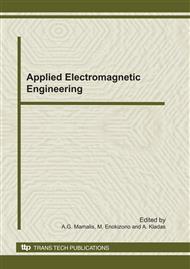p.235
p.243
p.252
p.259
p.265
p.275
p.284
p.291
p.299
Coupled Field and Circuit Model Analysis of Permanent Magnet Synchronous Machine for Direct Torque Control Optimization
Abstract:
The pulsating torque of a permanent magnet motor has detrimental effects on the motor operation, resulting in speed perturbation, positioning error, vibration, and noise. Several efforts of countering the torque ripple focus on magnet pole shape optimization procedures while other efforts apply sophisticated modifications of control algorithms. In this paper a coupled field and circuit model of a permanent magnet synchronous machine (PMSM) is introduced in order to reduce the effects of pulsating torque. The model comprises of a 2D finite element model for detailed computation of the machine field distribution coupled with an external equivalent circuit for macroscopic parameter evaluation. Model results are then integrated in a direct torque control algorithm for the minimization of torque ripple in a PM machine prototype.
Info:
Periodical:
Pages:
265-272
Citation:
Online since:
December 2010
Price:
Сopyright:
© 2011 Trans Tech Publications Ltd. All Rights Reserved
Share:
Citation:


